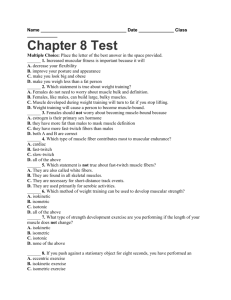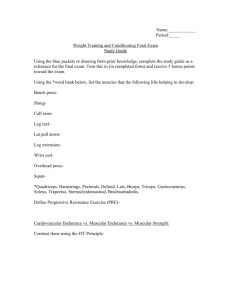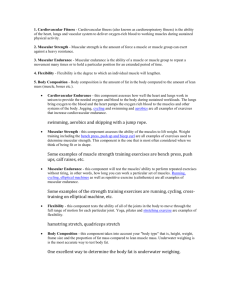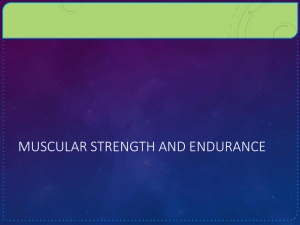Designing Resistance Training Programs
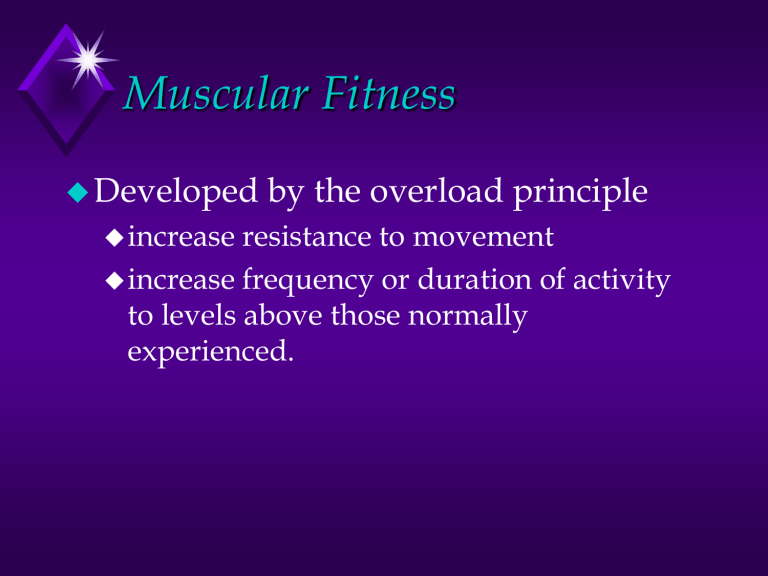
Muscular Fitness
Developed by the overload principle
increase resistance to movement
increase frequency or duration of activity to levels above those normally experienced.
Muscular Strength
Best developed by using weights that develop maximal or nearly maximal muscle tension with relatively few repetitions
Muscular Endurance
Best developed by using lighter weights with a greater number of repetitions.
Guidelines
The following resistance training guidelines are recommended for the apparently healthy adult:
Guidelines
A primary goal of the program should be to develop total body strength and endurance in a relatively time-efficient manner.
Guidelines
Programs lasting longer than 1 hour per session are associated with higher dropout rates.
Guidelines
While more frequent training and additional sets or combinations of sets and repetitions elicit larger strength gains, the additional improvement is relatively small.
Guidelines
Adhere as closely as possible to the specific techniques for performing a given exercise.
Guidelines
Perform every exercise through a full range of motion.
Guidelines
Perform both the lifting (concentric phase) and lowering (eccentric phase) portion of the resistance exercises in a controlled manner.
Guidelines
Maintain a normal breathing pattern, since breath-holding can induce excessive increases in blood pressure.
Guidelines
If possible, exercise with a training partner who can provide feedback, assistance, and motivation.
Improvement
Muscle strength and endurance gains will be determined by:
Training
Nutrition
Genetics
Hormone secretion
Specificity
The development of muscular fitness is specific to the muscle group that is exercised, the type of contraction, and the training intensity.
Specificity
Strength and endurance gains are also specific to the speed and range of motion used during training.
Overload
To promote strength and endurance gains, the muscle group must be exercised at work loads that are greater than normal for the client.
Overload
The exercise intensity should be at least
60% of maximum to stimulate the development of strength.
Overload
More rapid strength gains may be achieved, however, by exercising the muscle at or near maximum (80 to
100%) resistance.
Overload
To stimulate endurance gains, intensities as low as 30% of maximum may be used; however, at low intensities the muscle group should be exercised to the point of fatigue.
Progression
You must periodically increase the training volume.
Progression
Progression needs to be gradually, because doing too much too soon may cause musculoskeletal injuries and excessive muscle soreness.
Progression
The number of repetitions a client is able to perform will indicate when the resistance needs to be increased throughout the training program.
Progression
The rate of improvement slows, and eventually plateaus, as clients progress through the program and move closer to their genetic ceiling.
Methods
Static (isometric)
Dynamic (concentric and eccentric, isotonic)
Isokinetic
Static
A major disadvantage is that strength gains are specific to the joint angle used during training.
Dynamic
Dynamic resistance training involves concentric and eccentric contractions of the muscle group performed against a constant or variable resistance.
Muscular Fitness
The intensity of resistance training can be manipulated by varying the weight, the number of repetitions, the length of the rest interval between exercises, or the number of sets of exercises completed.
Intensity
Intensity is expressed either as a percentage of the individual’s 1-RM or as the maximum weight that can be lifted for a given number of repetitions of an exercise (e.g., 8-RM equals the maximum weight that can be lifted for 8 repetitions).
Intensity
Intensity is inversely related to the number of repetitions.
Intensity
A set consists of a given number of consecutive repetitions of the exercise.
Intensity
Training volume is the total amount of weight lifted during the workout and is calculated by summing the products of the weight lifted, repetitions, and sets for each exercise.
Intensity
The optimal training stimulus for strength development is high intensity low repetitions; whereas, low intensity high repetitions optimize muscular endurance gains.
Intensity
To optimize strength gains, the intensity should be set at 80 to 85% 1-
RM.
Intensity
At this intensity, most individuals are able to perform 6 to 8 repetitions (6 to 8
RM) of the exercise.
Intensity
However, when your client’s primary goal is to develop muscular endurance, prescribe an intensity of < 60% 1-RM
(15 to 20 RM).
Intensity
For advanced strength training and hypertrophy programs, large training volumes are achieved by increasing the number of sets, performing multiple exercise for each muscle group, and increasing the frequency of training.
SETS
Although improvements in muscular fitness may result from performing only one set of a given exercise, research suggests that multiple sets (3 or more) are more beneficial for optimal gains in muscular fitness.
Frequency
Improvements in muscular fitness may result from exercising just one day per week, especially for clients with belowaverage muscular fitness.
Frequency
However, research suggests that exercising 3 times per week improves both the rate and amount of strength gain.
Frequency
For advanced resistance training programs, a frequency of 5 to 6 days per week will provide the high training volume necessary to stimulate further gains in muscle strength and size.
ACSM Recommendations
The ACSM recommends one set of 8-10 exercises that condition the major muscle groups 2-3 days per week.
(1998).
ACSM Recommendations
Multiple-set regimens may provide greater benefits if time allows.
ACSM Recommendations
Most persons should complete 8-12 repetitions of each exercise; however, for older and more frail persons
(approximately 50-60 years of age and above), 10-15 repetitions may be more appropriate.
Order of Exercises
Order the exercises so that your client first executes multi-joint exercises -such as the seated leg press, bench press and lat pull-down -- that involve larger muscles and more muscle groups.
Order of Exercises
The have your client progress to singlejoint exercises for smaller muscle groups.
Order of Exercises
To avoid muscle fatigue in novice weightlifters, arrange the exercises so that successive exercises do not involve the same muscle group.
Order of Exercises
This allows time for the muscle to recover.
Order of Exercises
When you prescribe two or more exercises for a specific muscle group, instruct the average individual to alternate muscle groups so that the muscle can rest and recover between exercises.
Order of Exercises
In contrast, most advanced weightlifters prefer to do compound-sets or tri-sets in order to completely fatigue a targeted muscle group.
Order of Exercises
To use this system, the client performs 2
(compound sets) or 3 (tri-sets) exercises consecutively for the same muscle group, with little or no rest between the exercises.
Pyramiding
Pyramiding is a light-to-heavy system in which the client performs as many as
6 sets of each exercise.
Pyramiding
Because this involves such a large volume of work, prescribe the pyramid system only for experienced weightlifters.
Supersetting
Many bodybuilders also use a training system called supersetting.
Supersetting
For supersets, the client exercises agonistic and antagonistic muscle groups consecutively without resting.
Supersetting
For example, to superset the quadriceps femoris and hamstrings, follow a leg extension set immediately with a leg curl set.
Variations of Frequency
Encourage your clients to workout 3 times per week on the days that best fit their schedules.
Variations of Frequency
For advanced resistance training programs, prescribe a frequency of 5 to
6 days a week.
Variations of Frequency
Most exercise specialists advocate a split routine, in which different muscle groups are targeted on consecutive days, in order to allow at least one day of recovery for each muscle group.
Variations of Training
Volume
To prevent overtraining and to optimize strength and power gains for peak performance, many athletes who train year-round divide their resistance training program into cycles.
Variations of Training
Volume
This method is known as periodization.
Variations of Training
Volume
Each macrocycle (usually one year), for example, can be divided into four, 3month mesocycles: preparation, first transition, competition, and second transition phases.
Variations of Training
Volume
The length and amount of mesocycles vary with the number of competitions.
Variations of Training
Volume
You will need to modify the training volume and intensity for each mesocycle.
Variations of Training
Volume
During the preparatory phase
(mesocycle I), prescribe high-volume, low-intensity exercise to increase muscle mass and muscular endurance.
Variations of Training
Volume
Gradually decrease the volume of training as the intensity is increased during the transition phase (mesocycle
II), culminating in “peak” performance during the competition phase
(mesocycle III).
Variations of Training
Volume
For the second transition phase
(mesocycle IV), have the athlete engage in low-intensity physical activities which may not include resistance training.
Circuit Training
Circuit resistance training compares favorably with traditional resistance training programs for increasing muscle strength, especially if low-repetition, high-resistance exercises are used.
Isokinetic Training
Isokinetic training involves dynamic, shortening contractions of a muscle group against an accommodating resistance that matches the force produced by the muscle group throughout the entire range of motion.
Isokinetic Training
The speed of movement is controlled mechanically by the isokinetic exercise device.
Isokinetic Training
Isokinetic training is done at speeds that vary between 24 and 300 degrees per second depending on the needs of the individual.
Comparison
All of the resistance training methods are effective for developing strength and muscle endurance.
Comparison
Dynamic training is preferable to static training (isometric) because dynamic training develops greater strength and muscular endurance.
Comparison
Motivation is generally superior with dynamic training, because the individual receives visual feedback concerning the amount of weight lifted, and can set explicit goals.
Comparison
Static exercise can effectively counteract strength loss and muscular atrophy when a body part is temporarily immobilized due to injury.
Comparison
Static exercise is also especially useful when circumstances do not allow the use of dynamic exercise (e.g., limited space and equipment).
Comparison
Isokinetic exercise combines the advantages of dynamic (full range of motion) and static (maximum force exerted) exercise.
Comparison
Since the resistance is accommodating, isokinetic training overcomes the weakness of using either a constant or variable resistance exercise mode.
Comparison
A major advantage of isokinetic training over traditional forms of training is that little or no muscle soreness results because the muscles do not contract eccentrically.
Comparison
In addition, isokinetic training as fast speeds apparently produces strength gains not only at the training velocity but also at speeds slower than the training velocity.
Comparison
Isokinetic training is not the best choice, however, when the goal of training is an increase in muscle size.
Comparison
Eccentric contractions apparently are essential for muscle hypertrophy.
Steps for Developing a Resistance
Training Program
1. In consultation with your clients, identify the primary goal of the program (i.e., strength, muscular endurance, muscle size, or muscle toning) and ask them how much time they are willing to commit to this program.
Steps for Developing a Resistance
Training Program
2. Based on your client’s goals, time commitment, and access to equipment, determine the type of resistance training program (i.e., dynamic, static, or isokinetic).
Steps for Developing a Resistance
Training Program
3. Using results from your client’s muscular fitness assessment, identify specific muscle groups that need to be targeted in the exercise prescription.
Steps for Developing a Resistance
Training Program
4. In addition to core exercises for the major muscle groups, select additional exercises for those muscle groups targeted in step 3.
Steps for Developing a Resistance
Training Program
5. For novice weightlifters, order the exercises so the same muscle group is not exercised consecutively.
Steps for Developing a Resistance
Training Program
6. Based on your client’s goals, determine appropriate starting loads, repetitions, and sets for each exercise, as well as frequency of the workouts.
Steps for Developing a Resistance
Training Program
7. Set guidelines for progressively overloading each muscle group.
Muscular Fitness
Caution is advised for training that emphasis lengthening (eccentric) contractions, compared to shortening
(concentric) or isometric contractions, as the potential for skeletal muscle soreness is accentuated.
Muscular Fitness
Resistance training for the average participant should be rhythmical, performed at a moderate-to-slow speed, involve a full range of motion, and not interfere with normal breathing.
Muscular Fitness
Heavy resistance exercise combined with breath-holding can cause a dramatic, acute increase in both systolic and diastolic blood pressure (Valsalva
Maneuver).

